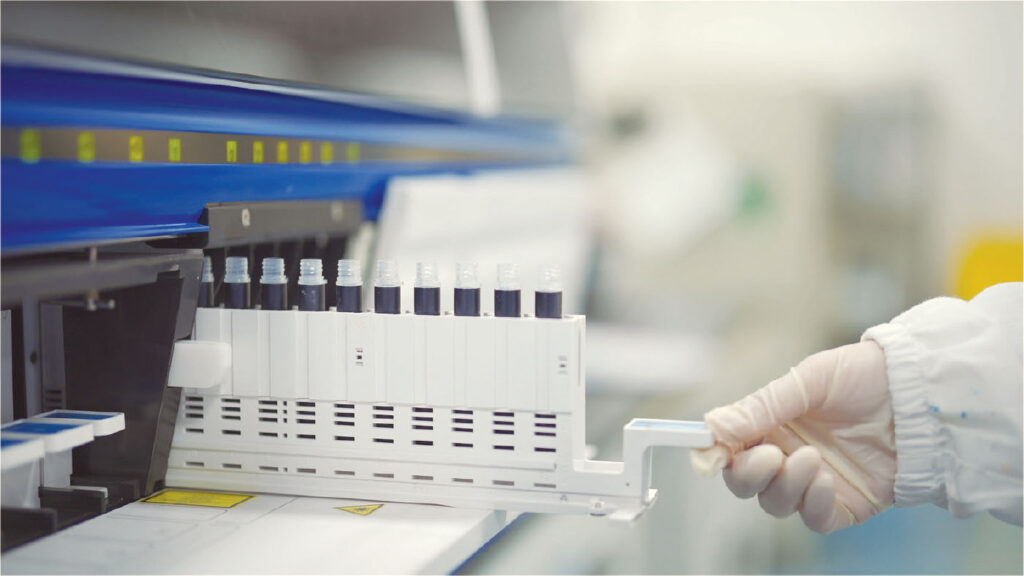Introduction
Microbial production systems, such as Escherichia coli and yeast, are becoming more important than ever in manufacturing innovative biologics—including nanobodies, enzymes, cytokines, growth hormones, virus-like particles, and other complex modalities such as protein-drug conjugates and cell therapies.1

VP, Head of Microbial and Viral Platforms (MVP), WuXi Biologics
Microbial systems offer distinct advantages in protein expression, saving costs and time, and offering well-characterized host genetics and ease of scale-up.2 However, challenges remain in process development and GMP manufacturing, including genetic and expression instability, leaky expression, toxic by-products (e.g., acetate), suboptimal post-translational modification (PTM), inclusion body formation, and intermediate instability. All of these may lead to a reduction in yield and/or product quality.
A novel E. coli expression system, EffiXTM, offers a comprehensive solution to issues across the entire CMC process. Combined with optimization in microbial process development and manufacturing, the system can help biopharma companies achieve stable, high-yield, high-purity biologics production cost-effectively.
Novel strain and plasmid design
Traditional microbial expression systems can be advanced through improved plasmid replication, target gene transcription, translation, and safety. This provides a robust foundation for stable and scalable manufacturing of novel biotherapeutics, particularly for those Difficult-to-Express (DtE) molecules.

Reliable genetic and expression stability
Optimized plasmid replication, maintained through at least 120 doubling passages without adding antibiotics is enabled through the EffiX system (Figure 1A). Meanwhile, the target protein is stably expressed (Figure 1B) with a 100% plasmid retention ratio. Genome-integrative expression, as an alternative to plasmid, has shown superior stability with a comparable expression level. These methods can be combined to co-express multiple machineries, enable a complex system such as non-natural amino acid incorporated recombinant protein expression, and help balance stable production and environmental sustainability.
Low basal expression by tight control of transcription
It is also possible to resolve the issue of basal (leaky) expression, commonly observed in conventional BL21(DE3)-pET systems, by stringent transcriptional control of target genes. Through plasmid engineering, target gene transcription can be tightly suppressed prior to induction, alleviating the metabolic burden. As a result, an optimal post-induction growth phase can be achieved and the titer of the target molecule may be improved by two- to five-fold (Figure 1C).
Removing unwanted PTMs to achieve high purity
For conventional BL21(DE3)-pET systems, especially in high-cell-density fermentation, target proteins tend to exhibit PTMs. The PTM species are difficult to remove during downstream purification, compromising final product purity. However, our approach can help engineer the post-translational modification pathway to eliminate species containing unwanted PTMs,3 which results in a high purity of the final product (Figure 1D).
Phage resistance by shutting down the phage infection pathway
Bacteriophage T1/T5 infection can lead to cell lysis and hence a reduction in titer. We address this issue by removing the intrinsic phage receptor in the host strain, thereby eradicating susceptibility to T1/T5 phage infection. Furthermore, the host strain we use is engineered to minimize the risk of lysogenic phage reactivation, a common problem observed with the widely used BL21(DE3) strain.4 This change safeguards large-scale production and helps save time, materials, and labor associated with phage decontamination (Figure 1E).
Toolbox for Difficult-to-Express (DtE) proteins
We have also built a toolbox that comprises various genetic elements such as replicons, promoters, operators, ribosomal binding sites, signal peptides, codon optimization algorithms, cleavable purification tags, and chaperones. This toolbox allows a precise tuning of transcriptional strength and translational efficiency and, with the aid of a high-throughput (HTP) screening platform, it enables the successful expression of >95% DtE proteins.
Fermentation process optimization

Establishing robust high cell-density processes
Process Analytical Technology (PAT) serves as a cornerstone for Quality-by-
Design (QbD) (Figure 2A), and enables us to monitor all critical process variables in real time. On the other hand, process modelling—particularly via a Design of Experiments (DoE) approach—is central to process optimization and characterization. DoE enables a systematic exploration of the design space to pinpoint optimal conditions for critical parameters. After identifying key parameters, by validating them through HTP screening in multi-parallel bioreactors, and confirming the model’s predictive power for scale-up, productivity, and quality, it is possible to establish robust high cell-density processes for high productivity and quality.
Microbial solutions to VHH production
Among all innovative biologics, VHHs (Variable domain of Heavy-chain-only antibodies) have received particular attention due to their unique properties, including small size, high solubility, and superior thermostability. Owing to the conserved disulfide bond, VHHs tend to form inclusion bodies when expressed intracellularly in E. coli. To overcome this challenge, we have used our EffiX system for VHH expression. Key process parameters have been systematically evaluated and optimized, such as induction biomass concentration, inducer concentration, feed rate, and temperature. As a result, a two-phase high cell-density fermentation process that significantly enhances protein transport and secretion has been established (Figure 2B). This process features two distinct pathways for releasing soluble VHHs—programmed cell lysis and targeted product release—thereby simplifying downstream purification steps. In one of the case studies shown in Figure 2C and Figure 2D, we demonstrate a 12-fold increase in titer and a five-fold increase in secreted VHH species, compared to a baseline process.
Purification of diverse modalities
Downstream purification, as the key segment of microbial processing, faces
additional challenges related to the increasing diversity and complexity of biologics.5 Common obstacles include low yield, high residual impurities, poor stability of intermediates, low refolding efficiency, and an overall absence of universal plug-and-play solutions. Over the past several years, we have worked to develop a versatile downstream toolbox tailored to various unit operations, including cell lysis, clarification, inclusion body refolding, and chromatography.

A unique His-SUMO tag solution
Recombinant proteins expressed in E. coli often exhibit heterogeneity at the N-terminal methionine residue, a phenomenon that can reduce biological activity in certain cases or hinder specific applications such as N-terminal modifications or conjugations. The addition of a His-SUMO tag at the N-terminus can reduce this heterogeneity (Figure 3). Moreover, adding a His-SUMO tag may improve the solubility of target proteins that are otherwise difficult to express, thereby obviating the challenges of inclusion body refolding. Subsequent purification via immobilized-metal affinity chromatography (IMAC) enables a high purity of >95%. Thereafter, the His-SUMO tag can be cleaved by SUMO protease and removed by a flow-through IMAC. Ultimately, the non-tagged protein can be further purified by a polishing step.
Inclusion body refolding platform
In certain cases, the refolding of inclusion bodies is unavoidable. The most common approach is dilution refolding, which typically involves large volumes of intermediate pools. Alternatively, albeit more technically challenging, on-column refolding can be employed to enhance downstream processes. It is known that refolding conditions are highly specific to target molecules and a low yield of correctly-folded protein is often observed. A HTP screening strategy leveraging a proprietary buffer database to help identify optimal refolding conditions helps improve yield. For example, in a recent case study, we were able to demonstrate an increase of 60% in on-column refolding efficiency compared to the baseline condition.
GMP scale-up, reproducibility, and flexibility

Robust scale-up and superior reproducibility
To ensure successful scale-up and batch-to-batch consistency from laboratory to GMP production, we have built new scale-up models that integrate key engineering parameters, including oxygen transfer rate (OTR), mixing efficiency/homogeneity, heat transfer coefficient, and power input/per unit volume (P/V).6 These models are further validated by comprehensive process characterization and real-time process monitoring, enabling a seamless transition from bench to GMP facility (Figure 4).
Flexibility in microbial GMP manufacturing scale
Driven by the unique market demands of individual biologics, the manufacturing scale of clinical/commercial batches for different biotherapeutics could vary. In order to accommodate dynamic requests in production scale, we have built a flexible microbial platform that encompasses a comprehensive bioreactor configuration, including multiple stainless-steel
systems (50L–15,000L) and single-use bioreactors (30L–300L), as well as
compatible downstream purification lines, supporting GMP manufacturing.
Conclusion
By overcoming strain-specific hurdles, utilizing comprehensive toolboxes in process development, and building up robustness in process scale-up, biologics developers can increase the potential of microbial expression systems to enable cost-effective production while enhancing product quality. The platform we describe here, together with flexible GMP manufacturing infrastructures, helps make microbial production more adaptable, scalable, reproducible, and affordable. By addressing these critical challenges, we are unlocking the full potential of microbial-derived biologics and clearing better pathways for advanced therapies such as antibody-drug conjugates and cell and gene therapies that will benefit patients across the globe.
Sam Zhang is vice president and head of Microbial and Viral Platforms (MVP) at WuXi Biologics.
References
- McElwain L, et al. Current trends in biopharmaceuticals production in Escherichia coli. Biotechnol Lett. 2022;44:917-931.
- İbrahim I, Kaplan O. Escherichia coli in the production of biopharmaceuticals. Biotechnol Appl Biochem. 2025;72:528-541.
- Li Z, et al. A novel Escherichia coli host cell, its construction method, and applications. PCT/CN2025/099418, under application.
- Li Z, Wu Q, et al. A novel Escherichia coli host cell, its construction method, and applications. PCT/CN2025/088184, under application.
- Bhatwa A, et al. Challenges associated with the formation of recombinant protein inclusion bodies in Escherichia coli and strategies to address them for industrial applications. Front Bioeng Biotechnol. 2021;9630551.
- Junker BH. Scale-up methodologies for Escherichia coli and yeast fermentation processes. J Biosci Bioeng. 2004;97:347-364.



